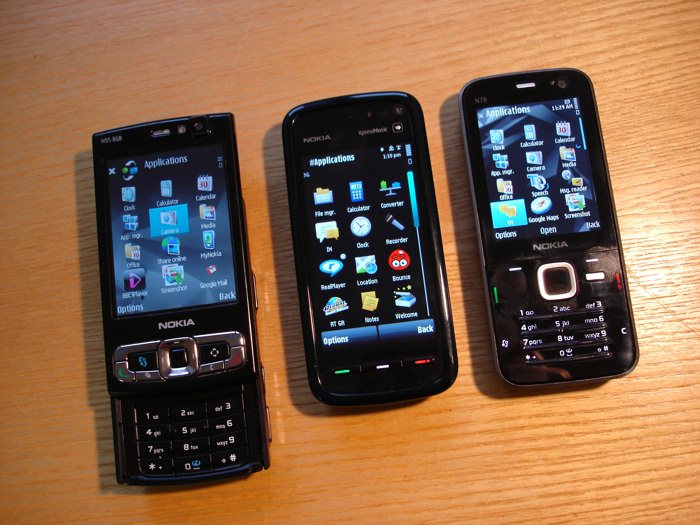Review: Nokia 5800 XpressMusic Preview - Part 3: Software, application compatibility and conclusions
In part three of our in-depth Nokia 5800 XpressMusic preview, Rafe looks at the remaining software on the phone, explains third party software compatibility and draws some conclusions.
Please bear in mind that these impressions, observations and pictures come from pre-release hardware and software.
You can read the other parts of this preview here: Part 1 - Hardware / Design and Touch and Implementation and Part 2 - Multimedia.
PIM and other software
The 5800's Contacts, Messaging and Calendar applications will be instantly familiar to any S60 user. There is little new functionality, but all three applications take advantage of the touch enablers and larger screen resolution.
Contacts uses the adaptive search I mentioned in the first part of this review, which means, even with large contacts lists (I tested 500+), individual contact entries are only a few taps away. Despite the bigger screen you'll still only see seven contacts displayed on screen at a time in the list view (because the bigger screen is offset by the need to make each contact 'fat' enough to touch), but you can see more information at a glance in the individual contact view. The on screen toolbar in list view also means fewer interactions are needed for the most common actions - making a call, sending a message and adding a contact. The 5800 supports voice dialing; it is activated by holding down the green call key for a second or so and is speaker independent (requires no training).

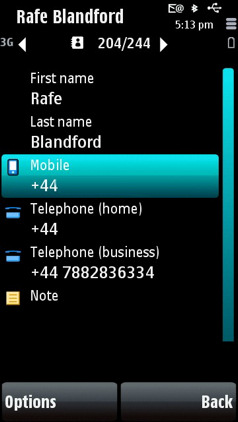
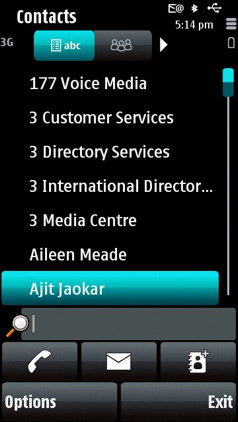
It’s a similar story for Messaging, where the extra screen real estate is especially welcome when reading email messages and the toolbar, again, reduces the number of interactions for key functions. Messaging has the same unified SMS/MMS composer which was first introduced in S60 3.2; MMS composition is easy with the touch screen, and regular texters will find the T9 text input provides a familiarity often absent from other touch-based devices.
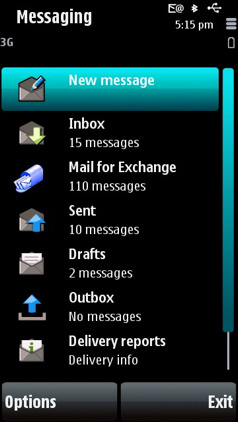
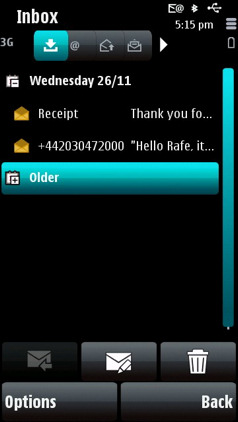
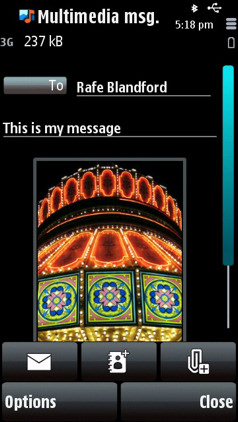
The 5800 also has the new email set up wizard which makes on-device email set up much easier (assuming your provider is in the database). Usually all that is required is your email address and password, the rest is done for you. There’s still no support for HTML email, which is disappointing, but basic email functionality is very solid.
Mail for Exchange, which adds support for Microsoft Exchange email and sync, is available from the Download! application and seamlessly integrates into Messaging. I would expect other push email systems to follow in due course. While mobile email is not going to be a primary use case for most 5800's users, it is still an important secondary feature point and the solidity of the 5800's implementation underlines the value of a platform approach.
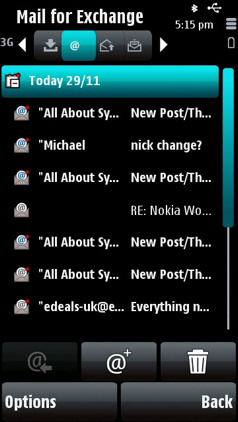
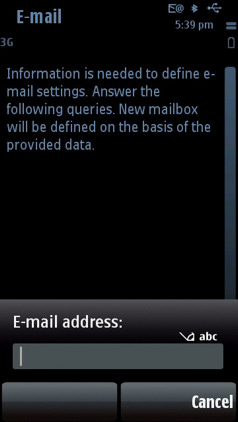
Calendar gets the biggest benefits from the UI makeover and larger screen resolution. For example, in the month and week views the screen is divided in two: the top half shows the usual overview, the bottom half shows details for the currently selected date or time. Previously most S60 devices, with their small screens, would only show the equivalent of the top half of the screen. In terms of information displayed, the 5800's Calendar implementation is similar to that found in the more recent Eseries devices, although the look follows the standard style of S60 rather than the Intellisync-inspired style found on the Eseries.
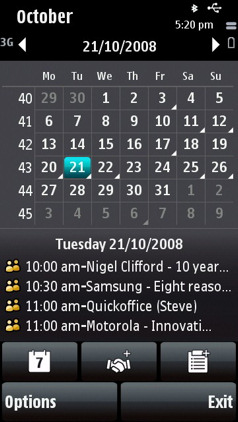
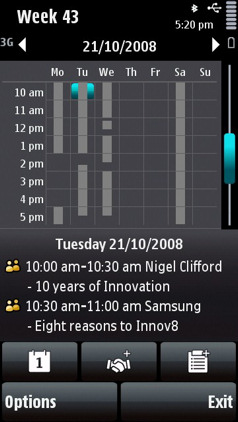
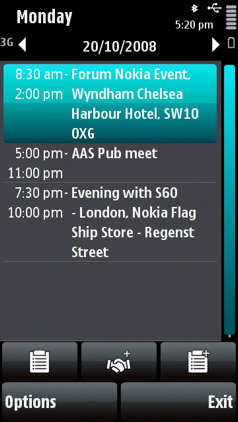
Calendar is particularly well suited to touch interaction. In most cases, the key actions can be accessed from the toolbar, or via on screen selection (e.g. dates and appointments behave like hyperlinks, moving you between views), which means the application feels smoother and more intuitive. It is a strong contrast with D-pad driven usage, which typically required frequent key presses to navigate around the application. As with previous versions, Calendar will leave power users underwhelmed (e.g. the lack of category support is a common complaint), but for the majority of people it will be more than sufficient and adding extra functionality has to be offset against the extra complexity it would add.
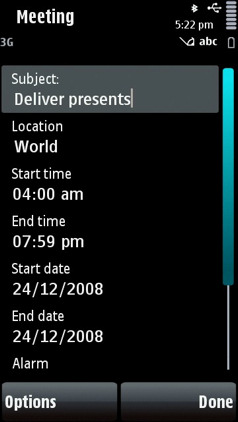
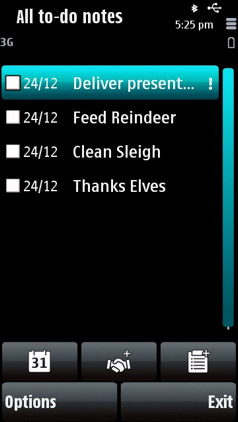
The Notes application is a basic port from non-touch S60; with no toolbar implementation, there's little in the way of touch extras. Later devices (or later firmwares) may get a version of Active Notes and some kind of scribble pad, but for now the implementation is underwhelming. It seems like a missed opportunity to take advantage of the touch screen.
Other S60 stalwarts (Clock, Converter, Calculator, Recorder, Location etc.) are also present and some of these, notably Clock and Calculator, have received significant visual overhauls. Clock finally takes advantage of the bigger screen, but looses its useful world clock view in the process (though it is present in the S60 5th Edition emulator). The 'helper' applications have made the jump to S60 5th Edition too; the Welcome, Switch and Settings wizard applications don't have the glamour of multimedia, but are still key ingredients in the early days of a users device ownership.
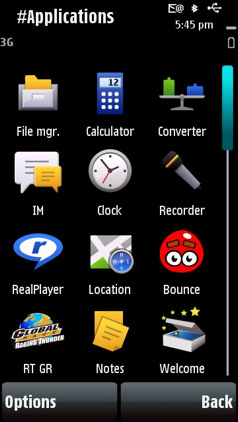
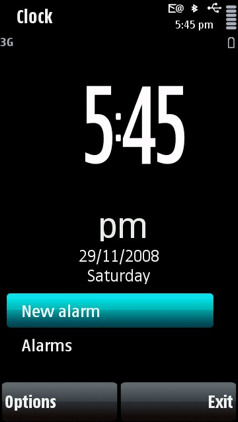
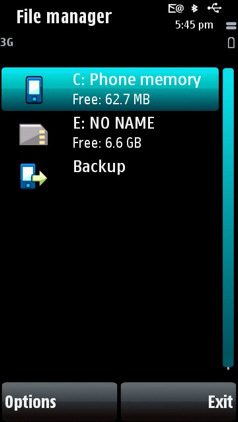
Application compatibility
As the first touch enabled S60 5th Edition device, the 5800 will face compatibility issues with older S60 software. However, unlike the move from S60 2nd to 3rd Edition, S60 5th Edition is binary compatible with S60 3rd Edition. This means that applications developed for S60 3rd Edition will run on S60 5th Edition. To be more accurate, applications which use standard S60 framework and UI components should run completely unmodified, but others may require changes. S60 5th Edition will automatically add touch control and haptic feedback (e.g. in a list component) to existing UI components, but applications will not be optimised for touch (e.g. they will not use new touch API functions such as the toolbar). While some software falls into this 'fully compatible' category (far-sighted developers will have considered this during development), much does not and thus the reality is more complex than the binary compatibility might suggest.
The first problem people are likely to face is when installing a SIS file. Installing software designed for S60 3rd Edition will trigger a strongly worded warning message: 'software is incompatible with your device', during the installation process. In most cases this can safely be ignored and has very little bearing on reality, but is probably enough to put off the novice user.
Many applications make assumptions that certain keys, most commonly the D-pad, are present on every phone, which, in the case of the 5800, is not the case. This means that many applications will run, but it might not be possible to make full use of them. A good example of this is the current version of Google Maps (no * and # keys means no zooming). Another common issue is that applications are designed to run at a specific resolution (games are often in this category). There are also some applications where changes in the APIs may render a portion of an application inoperable; although to be fair, the only example of this that most users will come across is that of accelerometer-based applications. The accelerometer is now accessed, programmatically, through the sensor framework (which is integral to the platform) rather than being a plug-in (which is device specific).
UPDATE: Compatibility mode is not in the final release firmware.
Some of these missing key and resolution issues are addressed by the provision of a compatibility mode: In the 5800's settings, there's an option to 'open non-touch applications' in either 'compatibility mode' or 'normal mode'. In compatibility mode, applications are restricted to a QVGA resolution sized area at the top of the screen and accompanied by an on screen virtual keypad. This adds to the number of applications that are 'compatible' with the 5800. In practise, compatibility mode provides a clumsy user experience, but it’s better than nothing. Unfortunately, it is an 'all or nothing' setting, i.e. it applies to all non-touch applications or to none. This is annoying because some non-touch applications (those that use standard S60 UI components and framework), such as Handy Safe, run correctly in 'normal' mode. It would be better if this setting were available on an application by application basis. It is also worth noting that some applications seem to ignore this setting (e.g. Google Maps), presumably because they declare themselves as being compatible even when they're not - which, again, makes something of a mockery of the current compatibility system.
Nokia Friend View running in compatibility mode.
In real world usage, leaving aside SIS installation issues and device specific requirements, I've found that about 25% of applications run without any problems, 15% or so have minor problems (but are still usable), and 60% do not run, have a major failure or are unuseable without the presence of keys. Of course, this will vary depending on the type of applications you use (power users may find a higher failure rate in beta and hobbyist applications). In any case, the compatibility issue will diminish in time as developers optimise their applications for touch and S60 5th Edition. Even for applications are 'fully compatible', its going to make sense for developers to repackage SIS files and to optimise for touch by taking advantage of the new enablers offered in S60 5th Edition (the toolbar component is the most visible, but not the only, example).
A number of developers have already released S60 5th Edition versions of their applications and some of these are available via Nokia's Download! application. Once the device is on the market I would expect this trend to accelerate. Developers wishing to test their software can take advantage of the documentation and remote device access available via Forum Nokia.
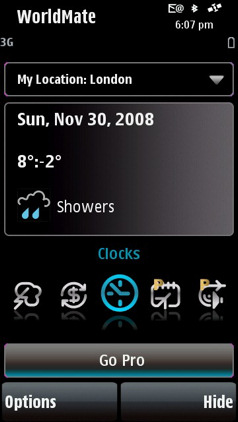
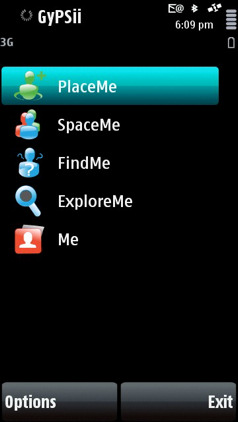
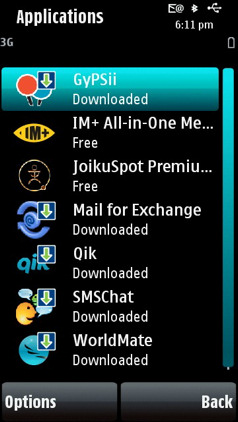
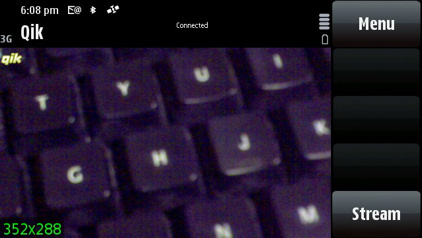
For Java software, the main compatibility issue is around the touch screen; relatively few Java applications are specifically enabled for touch. As with Symbian applications, the standard Java UI 'widgets' have touch control and haptic feedback added automatically by S60 5th Edition (i.e. a developer can use a list control without worrying about how an item on that list is selected), but custom controls (fairly common, especially in Java games) must be specifically enabled for touch.
Nokia have also added a compatibility layer for Java applications that shows an on screen D-pad, softkeys and game keys. Unless specified otherwise in the JAD (manifest) file, this virtual compatibility keypad will be shown automatically. However users do have the option of turning it on or off manually via the settings in the Application manager. This means that these, unlike Symbian applications, can have the compatibility layer turned on or off on an application by application basis, making it much more useful. This means that most Java applications will run on the 5800, but those with custom controls will need modifying to take advantage of the full screen resolution and the rest need to take compatibility mode into account. In practise this means that most Java applications work well, even in full screen mode, but Java games tend to need to run with the compatibility controls in place.
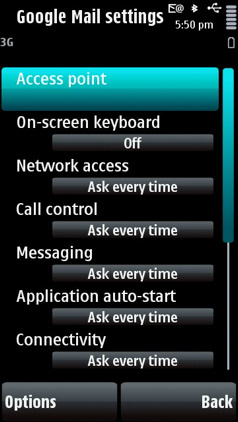
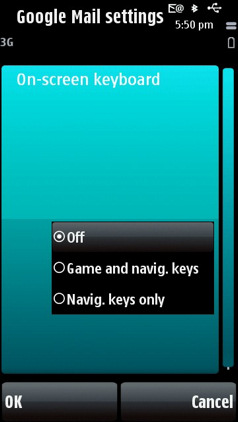
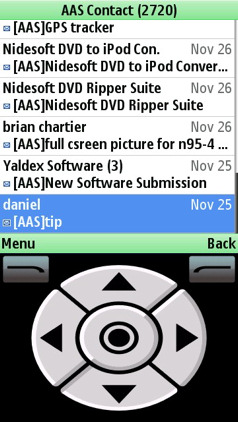
Web Run Time widgets and Flash Lite applications will run on the 5800, unchanged but, depending on how they are written, may not take advantage of the full screen. For example, most applications on this type are written for QVGA screen in portrait orientation. The same will apply to other runtime-based applications (e.g. Python) when these are released for S60 5th Edition.
Availability
The 5800 will be available in selected markets (Indonesia, United Arab Emirates, Hong Kong, Taiwan, Russia and Spain) from the beginning of December. It will become more generally available in the first quarter 2009; it is expected to arrive on the UK high street at the end of January and will likely reach the US sometime in February. There will be a US 3G variant as well as a Chinese variant (no 3G, EDGE connectivity instead).
The price point is based around 279 Euros before taxes and subsidies, but the street price will vary considerably. For example, in the UK it will be available as a Comes with Music phone which will add around £50 to the price of the vanilla model. In Spain it is being released at 429 Euros, but that includes a 100 Euro music voucher and a number of other extras.
Conclusions
For many, the immediate temptation with the Nokia 5800 is to compare it with devices like the iPhone, T-Mobile G1 or HTC's Touch range. But, while this is instructive to a certain degree, it rather misses the point. The most significant thing about the 5800 is not in its hardware, but in its price. With a SIM-free street price of around £270 (279 Euros, before taxes and subsidies), it is an impressive value proposition and is around a third to a half of the (all in) price of the high end touch devices to which it is being compared. This means that the 5800 is really in a completely different market segment to devices like the iPhone, G1 and Samsung Omnia. However, it’s not really this simple as media and marketing (and the current absence of other Nokia touch devices) will force a certain amount of direct comparisons.
Moreover, device subsidies add to the complexity of the picture. Even the highest priced devices are generally available in the UK for free on a contract, which dilutes the impact of price differences in high end mobile devices. However, it is likely that the 5800 will be available for free on the lower price tiers of monthly contracts (£25), which will give it a bigger addressable market. Perhaps more significantly, it will also mean better margins for operators who might be more inclined to spend all important marketing funds on the device (though this is offset by the aggressive Nokia services drive that is an integral part of the 5800's offering).
Up to this point, the market for touch based phones has been relatively roomy. Nokia's absence has seen success for a number of companies including HTC, Apple, Samsung and LG. However, with Nokia's entry into this space, even with a widening of the marketplace, 2009 will see much fiercer competition. For the 5800 offers Nokia's competitors a glimmer of what is to come. It is a point that is worth underlining - in terms of strategy, the 5800 should not be seen in isolation - Nokia will release a number of touch-based devices across a whole range of price points in 2009. The canny consumer might be well advised to wait a few months to see what is offered at Mobile World Congress 2009.
Despite their relative importance in 2009, touch devices are still something of a distraction from where the real battle for the future will be happening - in software and services. Hardware will, of course always be important, but, for the most part, any of the major manufacturers are now capable of producing similar hardware. Instead, software and services will continue their trend of playing a more important role in product differentiation. This is not to say that technical innovation is unimportant, but I think it will, at the macro level, take at least equal billing with other factors such as design, economies of scale and service implementation. Price will remain a significant factor, especially given the economic circumstances, and as open platform-based devices continue to drive into the mid tier. This is an area where Nokia, with devices like the 5800 and E63, has been particularly aggressive towards its competitors of late.
It is also worth emphasising that, despite the excitement around touch, the vast majority of phones being sold are still softkey-driven non-touch devices. Even if you restrict your view to the open platform space, the majority of devices sold do not have a touch screen (though a higher proportion do). This is a trend I fully expect to continue in the future; pure touch devices will make up a minority portion of the overall market.
It is also instructive to compare the 5800 to Nokia's existing Nseries portfolio. Its hardware specifications limit its multimedia creation capabilities, although it is still a reasonably capable device. Significantly, however, its high resolution screen makes for a better multimedia consumption, especially when watching videos or browsing the web; one that is, arguably, better than higher priced QVGA equipped Nseries devices. This makes the Nokia 5800 one of Nokia's best all round multimedia devices ever.
Nokia has led the mobile industry in creating the market for converged multimedia devices, but has recently faced an increasing amount of competition. While it has maintained much of its leadership in mobile multimedia content creation, it has, arguably, seen its rivals, with their touch screen devices, steal a lead in the multimedia consumption area. The 5800, despite being a mid-range device, goes a long way to addressing this. No doubt the touch-enabled Nseries devices that are on the way will provide an even stronger response.
Rafe Blandford, All About Symbian, 26 Nov 2008
See Also
Nokia 5800 XpressMusic announced
Nokia 5800 XpressMusic Preview Part 1 - Hardware / Design and Touch Implementation
Nokia 5800 XpressMusic Preview Part 2 - Multimedia
Reviewed by Rafe Blandford at

